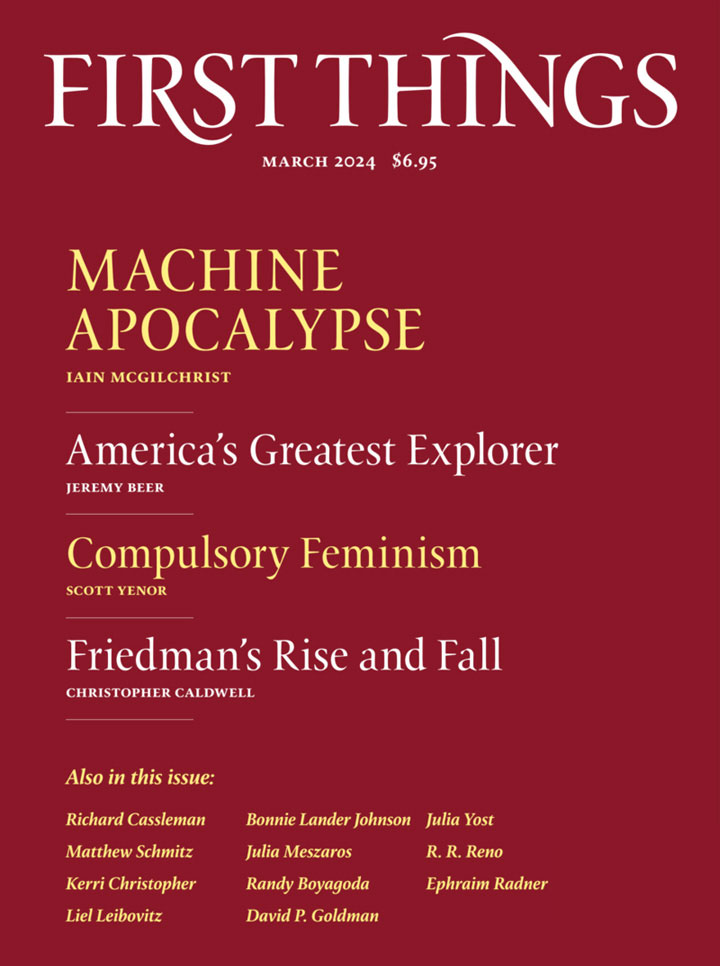Years ago, I spent a month with my family in Burundi. I had once worked there when still single. During this visit, my daughter took French lessons from a local teacher in the small provincial center where we were staying. At one point, M. Jérôme, the teacher, asked her why Europeans give flowers as gifts. “They’re beautiful,” my daughter said. M. Jérôme shook his head with exasperation. “That makes no sense. We like cows, not flowers.” People think differently. That may be obvious, but we often forget this in our rush to assert the truth.
Our cultures and personal habits shape how we think. Flowers versus cows. Social values are at work here, but also the very shape of our survival and relationships: seasons, kings, armies, markets, factories, grandparents, universities, restaurants, hillsides, and deserts. Navigating each of these over time, and with others, orders the logic of our reasoning and judgments. What if Pascal had lived in Sumatra?
Philosophers and theologians have tried to identify ways of thinking that will get everyone on the same page of truth. Methods and manuals were offered on the basis of this conviction. Ramon Llull, the thirteenth-century theologian and missionary to North Africa, wrote the Ars Magna, detailing methods of thinking, demonstration, and contemplation that he believed applied universally to all minds and hearts, and could thus be used to convert the Muslims. Antoine Arnauld and Pierre Nicole’s massively popular Logique de Port-Royal was a seventeenth-century handbook on correct thinking that they believed could reform French society (and convert Protestants).
But philosophers and theologians differ widely; they process information differently, start from diverse premises, have personal preferences. One of the most popular characterizations of intellectual “ways of thinking” is Isaiah Berlin’s distinction between the fox and the hedgehog, from the Greek poet Archilochus’s short lyric: “The fox knows many things, but the hedgehog knows one big thing.” Berlin makes much of the differences. In a celebrated essay on Tolstoy, Berlin presents the novelist as a natural “fox,” examining the details and corners of individual psyches and interactions. But Tolstoy was uncomfortable with his own subtle outlook. So, according to Berlin, he went against his own intellectual style and sought a grand theory or big picture of things (in religious matters especially). By Berlin’s reckoning, this endeavor was ultimately both simplistic and distorting. Hegel and Marx were, in Berlin’s view, just plain hedgehogs, and that was a problem in rather deep and terrible ways. Though he was too careful to be blunt—too foxy—Berlin believed that theory-generating hedgehogs, while perhaps more thrilling to read, were more dangerous.
Theologians often fit this scheme. A Hegelian religious thinker will perforce be a hedgehog, while the more Lockean thinker leans to the fox. The boundaries blur; but so do the contradictory logics within any given writer. Are St. Bernard’s sermons on the Song of Songs foxy in their scriptural detail or hedgehog-like in their figural ambition?
Another scheme, which I’ve seen applied to science, is the contrast between bleeder and surgeon. It’s based on the transitional period of early modern medicine, when bloodletting was giving way to dissection and intervention. Bleeders “let things out” in various ways in order to heal (the Galenic notion of restoring humoral balance), while surgeons “go inside and fix things.” Applied to modern science, there are “bleeder” empiricists, who lay things on the table and sort through them, and theoretical “surgeons,” who burrow down and tie things up, getting at the roots and closing things off. Linnaeus on the one hand, Newton on the other. I’m not sure where theologians fall. Hamann the Bleeder vs. Kant the Surgeon? Perhaps fideism puts things on the table, as it were, to believe or not, while rationalism probes for a grand theory of religious truth.
I once proposed to my students my own theological paradigm for distinguishing intellectual approaches. It is based on a culinary classification—with apologies to vegetarians, because it only really works with meat. There are Stewers, Roasters, and Curers.
Stewers identify a base—beef or chicken, say—but then add all kinds of things and cook them together. And one can make many stews from the same base meat, altering spices, herbs, vegetables, broths, temperature, timing. As for roasters, we are talking about traditional roasting of the whole animal (pig or goat, say), not the lazy roasting of chicken legs on a Weber grill. One might “stuff” the animal with something—herbs, vegetables, or, if you are a medieval pope, a bunch of starlings. But it is the “whole animal” that represents the main substance and ordering flavor; the stuffing is incidental, and only works from within. A curer is yet another approach. He takes a particular cut of meat and works on it in a very particular way to create a very particular and cherished food: prosciutto, soppressata, jambon de Bayonne. These cured delicacies are all different, each made a distinct way, and all quite limited in their purpose, usually never eaten “alone” but served as a dish with others.
On this paradigm, Karl Rahner was a skilled curer (as are most Catholics, who enjoy a large buffet of diverse cured meats), while his attempts at roasting were less satisfactory. Barth, for all his varied accomplishments, was first and foremost a roaster (as are most Reformed). Anglicans tend to be stewers. Even when they seem wedded to a given concept or theory, they almost always end up mixing things into it that produces something rather less obvious (though not necessarily without a distinct taste). Thomas Cranmer loved to talk about “chewing,” “ruminating,” and “savouring” Scripture, which can be applied to all kinds of meats, but tends to favor those slowly cooked and ingested.
My culinary paradigm (no doubt food metaphors say something about me) can be supplemented by the fox and hedgehog distinction, though in general I believe hedgehogs tend to its-all-in-the-meat roasting, while foxes end up curing, since a close empiricism seeks to transform telling details into delicious insights. When it comes to the bleeder–surgeon distinction, it’s clear that stewers are closer to bleeders. The ingredients need to be chopped and sorted. Surgeons are roasters or curers.
A colleague of mine suggested distinctions between driving, walking, and staying home. Drivers are like hedgehogs: They have a destination that determines everything. But they are not terribly concerned about concepts. They want to get to where they need to go, and thus their methods tend to be measured by efficiency, lack of distraction, reliable forward motion. Most contemporary theologians are trained to be drivers (whether they are good drivers is another question). Which is why most contemporary theology books can be read quickly, from the conclusion backward. Theologies of “liberative praxis” and “radical inclusion” provide obvious examples.
Walkers take their time. Perhaps there’s a destination in mind, but what counts is the landscape, the trees, the details along the way. There are pauses, hoverings, backtrackings. Anglicans (of the past) were often walkers. Even Hobbes (who I think is foxier than he is often read as being) would carry a pen in the top of his walking stick to jot down thoughts gleaned “along the way.”
I admire the homebodies: They burrow down into something and learn it inside out. A career can be made (and should be) by zeroing in on local mollusks (as did the hyper-Protestant naturalist Philip Henry Gosse) or anemones. J. B. S. Haldane’s celebrated quote that God must have “an inordinate fondness for beetles” is the judgment of a naturalist, but it also ought to be one of a theologian. The doctrine of justification as expounded in Switzerland in the late sixteenth century has wondrous folds of character and detail, indicating a divine fondness for theological nuance and its embodiment.
God is fond of everything, and knows all the roads, and has traveled everywhere both fast and slow. God delights in flowers and cows both, sets a beautiful table and cultivates the perfect plot. If I am a stewer and a walker, I dare not always be these. And if I am hard-pressed to don the mask of fox or hedgehog, it is because I need both and sometimes neither to get at the truth.
There’s another category of thinking: the waiter. Negatively, waiters are those who just float along, barely thinking at all, grabbing at this or that, carried by unknown currents. This is the thought mode of the Internet Age: the mind as flotsam.
But there’s a positive vocation for the waiter, one of letting go and trusting. Thomas Aquinas was a waiter. Having gathered up all the knowledge that one can, garnered in every frame of thought, he let it loose, like a flock of doves, content to gaze up at the sky and wait for their return in some new formation or other, great or small. We should be waiters in that sense, adopting a posture of hard-earned and trembling patience: Fear God, and so begin to be wise (Ps. 111:10).
Letters
As a Protestant, I began Valerie Stivers’s “How I Learned to Love Confession” (November 2025) mentally recalling…
In Praise of Translation
This essay was delivered as the 38th Annual Erasmus Lecture. The circumstances of my life have been…
Caravaggio and Us
Nicolas Poussin, the greatest French artist of the seventeenth century, once said that Caravaggio had come into…



